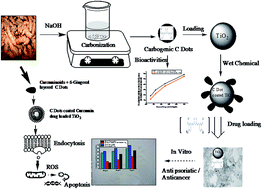Encapsulation of curcumin over carbon dot coated TiO2 nanoparticles for pH sensitive enhancement of anticancer and anti-psoriatic potential
Abstract
The surface engineering of rutile phase TiO2 nanoparticles was performed by carbogenic carbon dots for biological applications. Carbon dots were synthesized by a green hydrothermal method from the ginger herb and TiO2 nanoparticles were synthesized by co-precipitation of TTIP. The carbon dots were successfully coated over the surface of TiO2 nanoparticles and the hydrophobic multi-therapeutic drug curcumin was wet loaded chemically. These nanostructures were characterized using UV-Vis, PL and FTIR spectroscopy and XRD and TEM analysis. The curcumin loaded C dot coated TiO2 nanoparticles have shown higher anticancer potential than unloaded nanoparticles on MCF-7 breast cancer cells and anti-psoriatic potential on HaCaT keratinocyte skin cells. The enhancement in biocompatibility was observed for curcumin after loading on TiO2 nanoparticles, thus destroying the hydrophobicity after C dot surface engineering.


 Please wait while we load your content...
Please wait while we load your content...